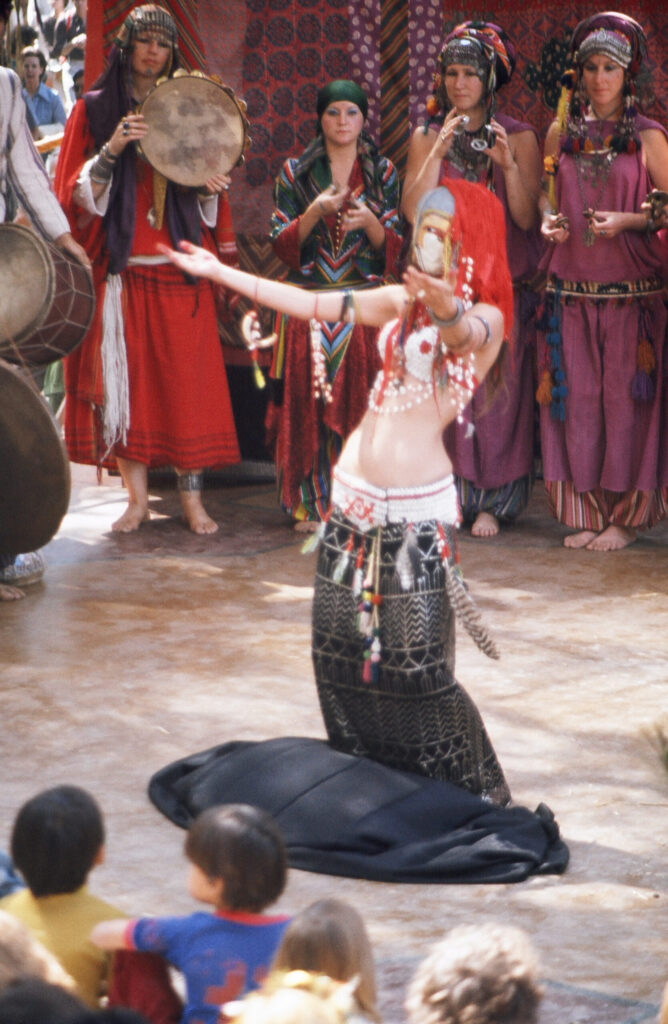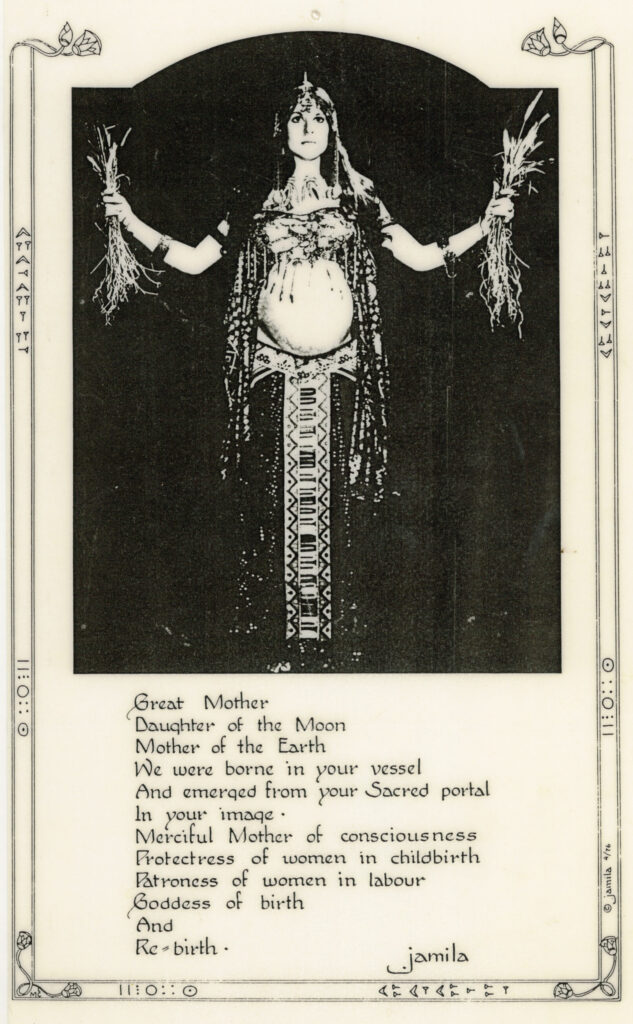Jamila Salimpour: Belly Dance Pioneer and the Mother Goddess Connection
Jamila Salimpour was a trailblazing figure in the world of belly dance, known for her deep and abiding fascination with the ancient Mother Goddess and matriarchal cultures. Her journey into the realm of belly dance was not just about the movements but a profound exploration of its historical and spiritual roots. This exploration was influential when she formed her legendary troupe, Bal Anat, and the creation of iconic performances such as the Mask Dancer solo. Let’s delve deeper into Jamila Salimpour’s life, her artistic endeavors, and the enduring influence of the Mother Goddess in her work.
Jamila Salimpour’s research into the origins of modern belly dance was marked by a desire to establish a connection between this art form and the ancient traditions that revered the Mother Goddess. She was inspired by the idea that belly dance might have deep roots in the worship of feminine deities associated with fertility, birth, and rebirth.
The Goddess Anat
When Jamila Salimpour developed and named her troupe Bal Anat, she drew from the name of the ancient goddess Anat. Initially, Anat was often described as a goddess of fertility in the research literature available at the time. However, later scholarship in the late 1900s began to dispute this characterization. Anat, as it turns out, was a multifaceted deity, embodying both masculine and feminine qualities. She was primarily identified as a warrior goddess. But it was the concept of a fertility goddess that drove Jamila’s inspiration.
The Pink Ladies: Sultry Taqsim Movements and Egyptian Court Ambiance
One of Jamila Salimpour’s early experiments in realizing her vision of the Mother Goddess was a poem and photoshoot of a pregnant woman. This depiction of a mother carrying a child was the epitome of Jamila’s vision of the Mother Goddess. One of her first representations was in a performance held on May 1, 1971 at the marriage of Raggedy Robin to Raggedy Jane at the Glide Church in San Francisco. In an image taken by photographer Robert Altman, a young black woman is seen at center stage with Bal Anat, dressed in a pharaonic-style costume as a fertility goddess.
Around this time, Jamila added another dance to Bal Anat’s repertoire. The Pink Ladies were a group of dancers who excelled at sultry taqsim movements and evoked an Egyptian court ambiance. The Pink Ladies were costumed in Cleopatra-styled wigs, providing a visual link to the grandeur and mystique of ancient Egypt. Through this performance, Jamila sought to connect the audience with the essence of the Mother Goddess, channeling her femininity and sensuality as well as her power and grace.
The Evolution of the Mask Dancer: A Timeless Symbol of Renewal
The Pink Ladies paved the way for the emergence of the Mask Dancer, a solo performance that would become the iconic opening act of the Bal Anat Show. The Mask Dancer was conceived as a representation of the Mother Goddess or Mother Earth herself. This enigmatic figure symbolized not only the beginning of time but also the perpetual cycle of birth and rebirth, an eternal guardian watching over the Earth.
The Mask Dancer was a later addition to Bal Anat’s repertoire, drawing inspiration from various sources, including the earlier Pink Ladies performance. This symbolic portrayal was a testament to Jamila Salimpour’s commitment to unraveling the mysteries of the Mother Goddess through dance and sharing her discoveries with audiences.
Bal Anat’s Legacy at the Renaissance Pleasure Faire
Bal Anat was born in 1968 and made its debut at the Renaissance Pleasure Faire. During its tenure at the Faire until 1974, the troupe left an indelible mark on the audience. One of the standout dancers during this period was Galya, considered by many to be the quintessential finale dancer. Her dance not only embodied the technical structure of the art but also captured the sentiment and styling that Jamila had envisioned for Bal Anat.
For the closing performance of each season at the Faire, Jamila Salimpour herself took the stage as the final soloist. Adorned in assuit and wearing her iconic headdress, she carried forward the legacy of Bal Anat and the deep connection to the Mother Goddess that had inspired its creation.
The Passing of the Mantle: Suhaila Salimpour and the Finale Dancer Role
Jamila Salimpour’s influence extended to her daughter, Suhaila Salimpour, who would carry the torch of Bal Anat into the future. In 1990, Suhaila was appointed as the finale dancer for a Bal Anat Reunion held in Dallas.
Even after taking on the role of director for Bal Anat in 1999, Suhaila continued to embrace the role of the finale dancer. On occasions, she cast Tom Rashid Ryan in the same role, infusing the performance with his version of the iconic tray dance.
In 2016, Suhaila selected Sabriye Tekbilek to take on the mantle of the finale dancer, showcasing the troupe’s commitment to evolving while maintaining its rich traditions. And in 2018, Isabella Salimpour made her debut in the same role, representing the new generation of dancers and the ongoing legacy of Bal Anat.
Jamila Salimpour’s influence extended to her daughter, Suhaila Salimpour, who would carry the torch of Bal Anat into the future. In 1990, Suhaila was appointed as the finale dancer for a Bal Anat Reunion held in Dallas.
Even after taking on the role of director for Bal Anat in 1999, Suhaila continued to embrace the role of the finale dancer. On occasions, she cast Tom Rashid Ryan in the same role, infusing the performance with his version of the iconic tray dance.
In 2016, Suhaila selected Sabriye Tekbilek to take on the mantle of the finale dancer, showcasing the troupe’s commitment to evolving while maintaining its rich traditions. And in 2018, Isabella Salimpour made her debut in the same role, representing the new generation of dancers and the ongoing legacy of Bal Anat.
Suhaila’s Stomach Dance: A Vibrating Expression of Art
Inspired by the Pink Ladies, Suhaila Salimpour carved her artistic path with the creation of the Stomach Dance. This mesmerizing piece became a featured highlight of her iconic Percussion Show. The dancers glide to the side using footwork that alternates bringing the toes and heels together.
Suhaila adapted her vision for the Stomach Dance in her full-length theater production, Sheherezade, which debuted in 2004. Suhaila envisioned the dance performed on conveyer belts with dancers executing the moves while vibrating. Due to cost constraints, the conveyer belts were not feasible. Instead, the performers used the original footwork to encircle a soloist on a platform, creating an elevated version of the dance. The featured dancer’s sustained vibrations added depth to the performance.
The Stomach Dance remains an important part of Suhaila’s Percussion Show, and it continues to evolve as one of the rotating acts for modern Bal Anat, showcasing the enduring creativity and innovation within the troupe while also recognizing and continuing tradition.
A Tribute to the Great Mother
The provided quote from Jamila Salimpour is a poignant tribute to the Great Mother, the Daughter of the Moon, and the Mother of the Earth. It encapsulates the reverence she held for the feminine divine, the protector of women in childbirth, and the embodiment of birth and rebirth.
In these words, Jamila Salimpour’s deep connection to the Mother Goddess is palpable. Her work with Bal Anat and the subsequent generations of dancers, including her daughter Suhaila and others, served as a vessel for expressing this profound spiritual connection through the art of belly dance.
Great Mother
Daughter of the Moon
Mother of the Earth
We were borne in your vessel
And emerged from your sacred portal
In your image
Merciful Mother of consciousness
Protectress of women in childbirth
Patroness of women in labour
Goddess of birth
And
Re-birth









